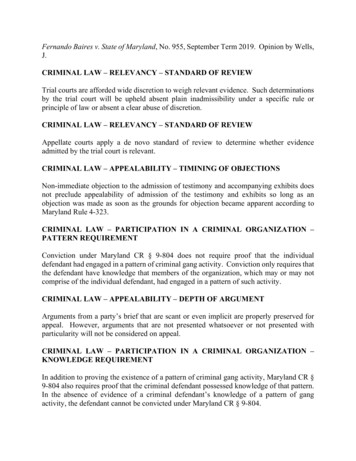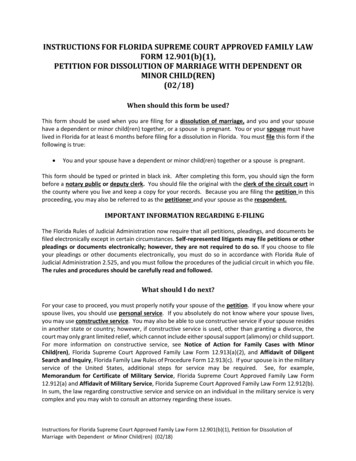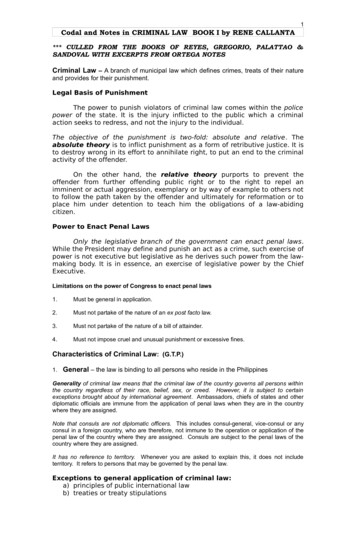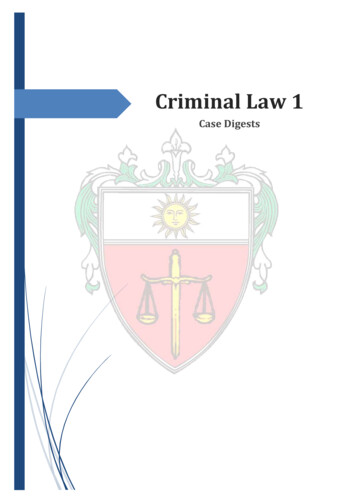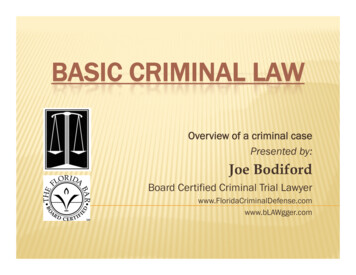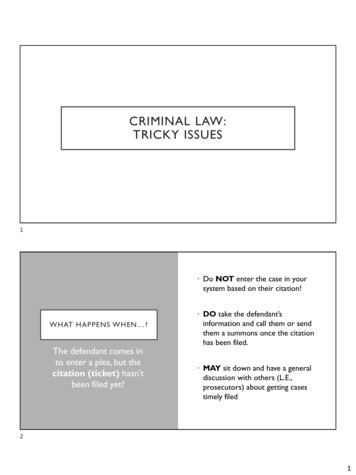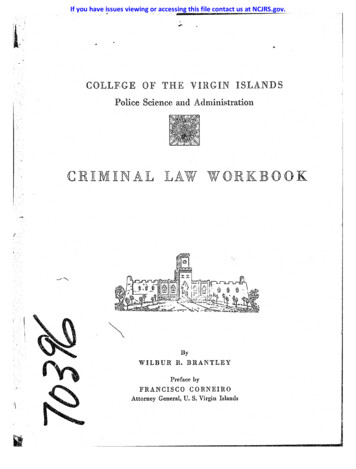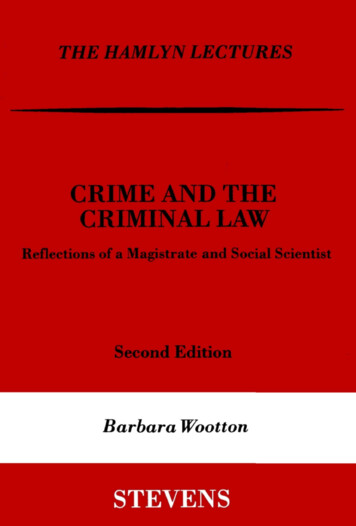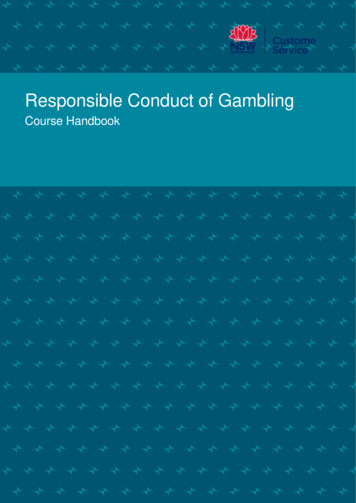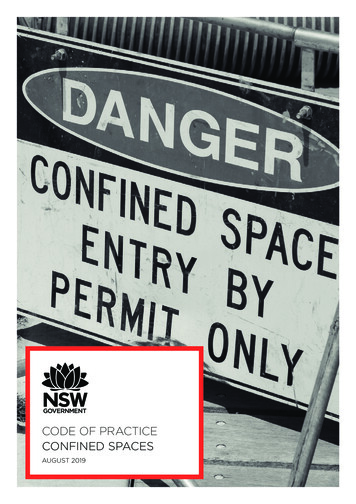
Transcription
CRIMINAL LAW REVIEWA paper for the District Court of New South Wales Annual Conference18 April 2017Justice Peter Johnson1This paper is intended to provide an overview of a number of recent decisionsof the High Court of Australia, the Court of Criminal Appeal and the SupremeCourt of New South Wales in the area of criminal law.Decisions of the High Court of AustraliaPresumption of Doli Incapax2Section 5 Children (Criminal Proceedings) Act 1987 provides for anirebuttable presumption that a child under the age of 10 years cannot be guiltyof an offence.For children aged between 10 and 14 years, there is arebuttable presumption that a child cannot possess the necessary knowledgeto have mens rea (doli incapax). Although doli incapax has been the subjectof a number of decisions of the Court of Criminal Appeal in recent times, ithad not been the subject of any recent High Court decision until RP v R[2016] HCA 53; 91 ALJR 248. That case involved alleged offences by a child(aged between 11 and 12 years) against his younger brother (aged six toseven years) being two offences of having sexual intercourse with a childaged under 10 years contrary to s.66A(1) Crimes Act 1900 and one offence ofaggravated indecent assault under s.61M(2).3At a judge alone trial which was confined to the doli incapax issue, the trialjudge found the appellant guilty of these three offences. On appeal to theCourt of Criminal Appeal, the Court (by majority) quashed the conviction withrespect to the s.61M(2) charge but dismissed the appeal against conviction onthe s.66A(1) matters: RP v R [2015] NSWCCA 215; 90 NSWLR 234. TheHigh Court allowed the appeal, quashed the convictions and entered verdicts1
of acquittal on the s.66A(1) matters. The judgment of the plurality (Kiefel,Bell, Keane and Gordon JJ) included the following propositions:(a)The rationale for the presumption of doli incapax is the view that a childaged under 14 years is not sufficiently intellectually and morallydeveloped to appreciate the difference between right and wrong andthus lacks the capacity for mens rea (at 250 [8]).(b)Under s.5 Children (Criminal Proceedings) Act 1987, there is aconclusive presumption that no child under the age of 10 years can beguilty of an offence, but the Act does not otherwise affect the operationof the common law presumption of doli incapax (at 250-251 [9]).(c)From the age of 10 to 14 years, the presumption may be rebutted byevidence that the child knew that it was morally wrong to engage in theconductthat constitutes the physical element or elements of theoffence – knowledge of the moral wrongfulness of an act or omission isto be distinguished from the child’s awareness that his or her conductis merely naughty or mischievous – this distinction may be captured bystatingthe requirement in terms of proof that the child knew theconduct was “seriously wrong” or “gravely wrong”(at 250-251 [9]).(d)No matter how obviously wrong the act or acts constituting the offencemay be, the presumption cannot be rebutted merely as an inferencefrom the doing of that act or those acts – the prosecution must point toevidence from which an inference can be drawn beyond reasonabledoubt that the child’s development is such that he or she knew that itwas morally wrong to engage in the conduct – this directs attention tothe child’s education and the environment in which the child was raised(at 250-251 [9]).(e)What suffices to rebut the presumption will vary according to the natureof the allegation and the child – a child will more readily understand theseriousness of an act if it concerns values of which he or she has direct2
personal experience – answers given in the course of a police interviewmay serve to prove the child possessed the requisite knowledge – inother cases, evidence of the child’s progress at school and of thechild’s home life will be required (at 252 [12]).(f)The closer the child defendant is to the age of 10 the stronger must bethe evidence to rebut the presumption – conversely, the nearer thechild is to the age of 14, the less strong need the evidence be to rebutthe presumption – however, it is not to be taken that all children matureat a uniform rate (at 252 [12]).(g)Rebutting the presumption directs attention to the intellectual and moraldevelopment of the particular child – some 10 year olds will possessthe capacity to understand the serious wrongness of their acts whileother children aged very nearly 14 will not (at 252 [12]).(h)It is necessary to keep in mind that a child under 14 years is presumedin law to be incapable of bearing criminal responsibility for his or heracts and the onus lies upon the prosecution to adduce evidence torebut that presumption to the criminal standard (at 255 [32]).4The Court of Criminal Appeal has recently considered RP v The Queen in thecourse of dismissing an appeal against conviction in AL v R [2017] NSWCCA34 (see [31]-[33] below).Doctrine of Extended Joint Criminal Enterprise5In Miller v The Queen [2016] HCA 30; 90 ALJR 918, the High Court confirmedthat the doctrine of extended joint criminal enterprise, as stated in McAuliffe vThe Queen [1995] HCA 37; 183 CLR 108, remained part of the common lawof Australia. The High Court rejected a submission that the law should berestated in accordance with the decision of the United Kingdom SupremeCourt in R v Jogee [2016] UKSC 8; [2016] 2 WLR 681. By reference to asecondary offender’s liability for murder, the plurality (French CJ, Kiefel, Bell,3
Nettle and Gordon JJ) explained extended joint criminal liability in thefollowing terms at 920 [1]:“ the doctrine holds that a person is guilty of murder where he orshe is a party to an agreement to commit a crime and foreseesthat death or really serious bodily injury might be occasioned by aco-venturer acting with murderous intention and he or she, withthat awareness, continues to participate in the agreed criminalenterprise”.6A helpful analysis of the history, development and operation of the concept ofextended joint criminal enterprise may be found in a paper of the Hon JusticeMJ Beazley AO entitled “Extended Joint Criminal Enterprise in the Wake ofJogee and Miller” (7 March 2017, Supreme Court Website).Trial by Jury for Commonwealth Offences Prosecuted on Indictment7In Alqudsi v The Queen [2016] HCA 24; 90 ALJR 711, the High Court (FrenchCJ dissenting) confirmed that trial by jury was required for a trial on indictmentof Commonwealth offences. The Court refused to overrule the decision inBrown v The Queen [1986] HCA 11; 160 CLR 171.8It remains the case that trial by judge alone under s.132 Criminal ProcedureAct 1986 is not available for trials on indictment of Commonwealth offences.The following observations of Kiefel, Bell and Keane JJ at 740-741 [119]-[120]are of particular interest (footnotes omitted):“[119] It is notable that the Director did not contend that trial byjury was ill-suited to long trials or to trials involving complexexpert evidence. The Director pointed to the discipline thattrial by jury imposes upon all the participants. If a casecannot be made comprehensible to a jury, the Directorasked how it can be made comprehensible to the accusedand to the public, who must ultimately support the criminalprocess.[120]The trial judge has mechanisms available to him or her todeal with adverse pre-trial publicity.These includeadjourning the proceedings for a period and givingappropriately tailored directions to the jury.Theadministration of criminal justice proceeds uponacceptance that a jury, acting in conformity with theinstructions given by the trial judge, will render a true4
verdict in accordance with the evidence. The applicant’sand the interveners’ assumption that the interest of justicewill, on occasions, be advanced by the trial on indictmentof an offence against Commonwealth law by a judge aloneshould not be accepted.”9Nettle and Gordon JJ said at 753 [194]-[195] (footnotes omitted):“[194] That ‘criminal trials today typically last longer, are moreexpensive and involve more complex issues’ may also beaccepted. That the decision making function of juries maybe at risk of being affected by adverse influences,including prejudice, may also be accepted. But ignoringthe text and constitutional context of s 80 is not a solution.These issues can be, and have been addressedlegislatively and through a variety of mechanisms designedto reinforce the institution of the jury trial. As seen earlier,the Commonwealth Parliament can designate whichoffences are to be by ‘trial on indictment’.TheCommonwealth Parliament can also determine thatwhether an offence is to be tried on indictment iscontingent on the satisfaction of certain conditions. It isneither necessary nor appropriate to determine whetherthere are other mechanisms or alternatives within thepower of the Commonwealth Parliament.[195] The criminal justice system is not naïve. While the lawassumes the efficacy of the jury trial, it does not assumethat the decision making of jurors will be unaffected bymatters of possible prejudice. What ‘is vital to the criminaljustice system is the capacity of jurors, when properlydirected by trial judges, to decide cases in accordance withthe law, that is, by reference only to admissible evidenceled in court and relevant submissions, uninfluenced byextraneous considerations.’ [Dupas v The Queen [2010]HCA 20; 241 CLR 237 at 248-249 [29]]. Legislative andprocedural mechanisms have evolved to reinforce thefairness and integrity of a jury trial. That is unsurprising.But those mechanisms reinforce, not destroy or detractfrom, a trial by jury.”Annulment of Conviction or Sentence10In Re Culleton (No 2) [2017] HCA 4; 91 ALJR 311, the High Court held that anorder of annulment by the Local Court under ss. 9 and 10 Crimes (Appeal andReview) Act 2001 operates prospectively only and not retrospectively. In thecourse of their judgment, the plurality (Kiefel, Bell, Gageler and Keane JJ)said:5
“(a)Section 9(3) requires the Local Court to proceed upon thefiction that a conviction has not been made because, intruth, the conviction was not a nullity from the beginning (at317 [27]);(b)The effect of s.10(1) is that an annulment does not purportretrospectively to treat the conviction as it if never occurred- the conviction ceases to have effect following annulmentbut is not void ab initio (at 317-318 [28]-[29]);(c)Although an absent offender was not liable to besentenced to imprisonment in their absence, once a s.25arrest warrant issued, the process of the law pursuant towhich the person might lawfully be sentenced toimprisonment had been set in train (at 318 [32]-[36]).”Reference on Sentence to the “Worst Category” of an Offence11In The Queen v Kilic [2016] HCA 48; 91 ALJR 131, the High Court expressedcaution concerning the use of the term “worst category” (or “worst case”) insentencing for a particular offence. It was observed (at 137 [18]) that anoffence may fall within this category even if it was possible to imagine an evenworse instance of the offence, referring to Veen v The Queen (No. 2) [1988]HCA 14; 164 CLR 465 at 478. The Court warned (at 137 [19]) that it may bepotentially confusing, and likely to lead to error, to describe an offence whichdid not warrant the maximum penalty as being “within the worst category”.12The Court observed further (at 137 [20]) that the common practice ofdescribing an offence as “not within the worst category” may be misleading tolay persons, and that the appropriate course is for sentencing judges to statein full whether the offence was or was not so grave as to warrant themaximum penalty.13Where the offence is not so grave as to warrant the maximum penalty, asentencing Judge is bound to consider where the facts of the particularoffence and offender lie on the spectrum that extends from the least seriousinstances of the offence to the worst category (at 137 [19]).6
Court of Criminal Appeal DecisionsSentencing for rolled-up counts and relevance of gambling addiction14In Johnston v R [2017] NSWCCA 53, the applicant pleaded guilty to a singlecount of obtaining a financial advantage by deception under s.192E(1)(b)Crimes Act 1900, an offence punishable by imprisonment for 10 years. Thisconstituted a rolled-up count involving the preparation of 156 false invoicesover a three-year period by which the applicant obtained 1,257,847.25, all ofwhich was dissipated in gambling. The applicant was employed by a miningcompany as a senior accountant. The sentencing judge imposed a sentenceof six years six months imprisonment with a non-parole period of four years.An appeal against sentence was brought upon a number of grounds.15The Court (Bathurst CJ, Johnson and Fagan JJ agreeing) said, with respect togrounds challenging the sentencing judge’s approach to the applicant’sgambling addiction:(a)the fact that offences were committed to feed a gambling addiction willnot generally be a mitigating factor at sentence, even where it ispathological - this is particularly so in cases where general deterrenceis an important factor and the offences are planned and perpetratedover an extended period (at [36]-[38]);(b)a gambling addiction will not generally reduce moral culpability wherethe offence is committed over an extended period as the offender has adegree of choice as to how to finance his or her addiction - the disorderwill not often be connected to the crime but merely provide a motive orexplanation for its commission, and is therefore only indirectlyresponsible for the offending conduct (at [38]);(c)the sentencing judge did not postulate a hierarchy of addiction placinggambling below drugs, but was simply stating that unlike some casesof drug addiction, the applicant did not lack the capacity to exercise7
judgment nor was the crime something other than a willed act - the factthat gambling addiction is listed in DSM-5 does not indicate to thecontrary (at [42]-[45]).16In considering a ground of appeal asserting that the sentence was man
CRIMINAL LAW REVIEW A paper for the District Court of New South Wales Annual Conference 18 April 2017 Justice Peter Johnson 1 This paper is intended to provide an overview of a number of recent decisions of the High Court of Australia, the Court of Criminal Appeal and the Supreme Court of New South Wales in the area of criminal law. Decisions of the High Court of Australia Presumption of Doli .


